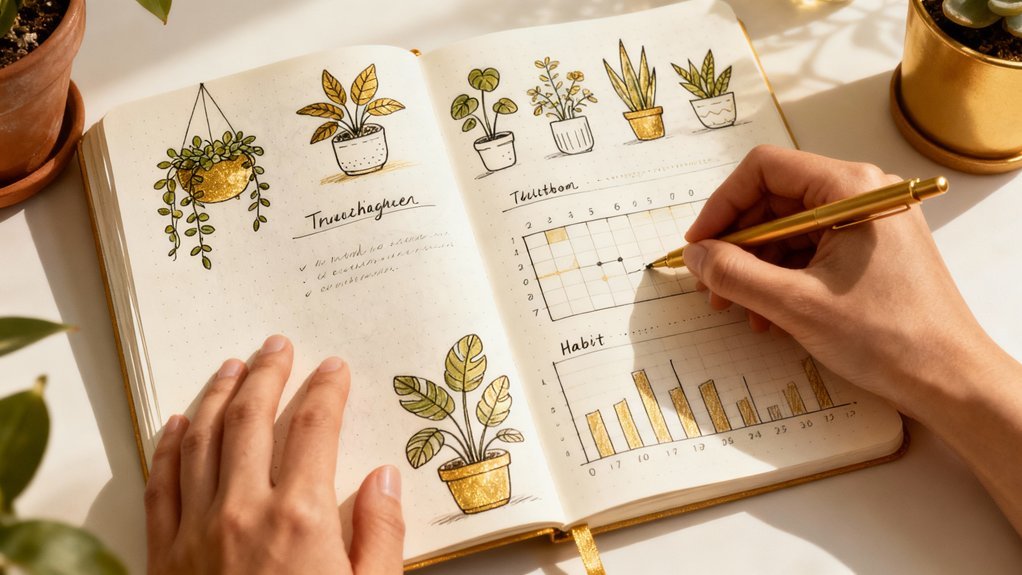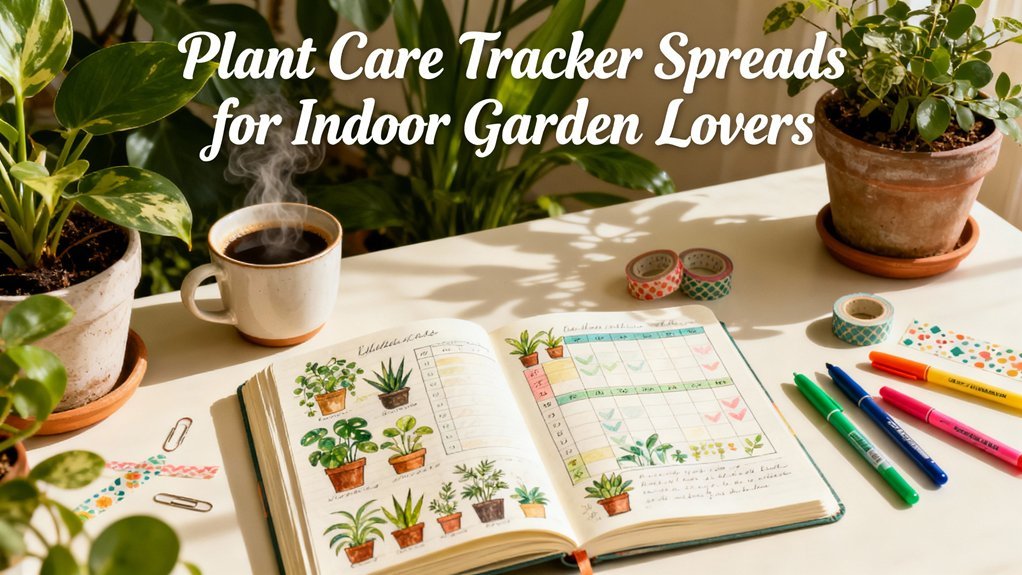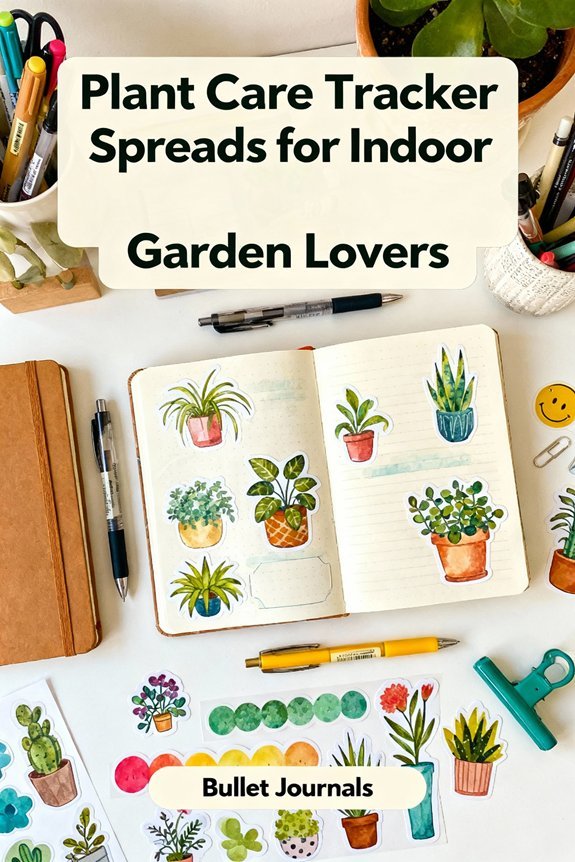You'll improve your indoor garden's success by implementing a thorough plant care tracker that documents botanical nomenclature, acquisition dates, substrate composition, and environmental parameters like luminosity and humidity ranges. Your tracking system should record irrigation schedules with precise volumes, fertilization protocols including NPK ratios, and growth metrics such as leaf count and vertical progression. Whether you choose digital platforms with automated reminders or analog methods for refined observational skills, incorporate color-coded health indicators, progress photo grids, and species-specific spreads for succulents, tropicals, and orchids. The sections below explore systematic approaches to structured plant documentation and troubleshooting methodologies.
Key Takeaways
- Track botanical names, acquisition dates, watering schedules, fertilization protocols, and growth measurements for comprehensive plant care documentation.
- Choose between digital trackers with automated reminders or analog systems that enhance observational skills and require no technology.
- Design custom spreads for different plant types: succulents need drainage data, tropicals require humidity tracking, orchids need bloom cycles.
- Include color-coded health icons, progress photo grids, and visual watering calendars to quickly assess plant conditions and track changes.
- Set up reminder systems for care tasks and document troubleshooting data linking symptoms to environmental conditions and interventions.
Essential Information to Include in Your Plant Care Tracker
A detailed plant care tracker requires specific data fields that enable systematic monitoring and informed decision-making. You'll need to document botanical nomenclature, acquisition dates, and substrate composition for each specimen.
Record environmental parameters including luminosity levels, humidity percentages, and temperature ranges to establish ideal growing conditions.
Environmental monitoring through precise luminosity, humidity, and temperature documentation establishes the empirical foundation for optimizing specimen cultivation parameters.
Track irrigation schedules with precision, noting volume and frequency to prevent root pathology. Document fertilization protocols by specifying NPK ratios, application rates, and intervals.
You'll want to monitor plant growth through quantitative measurements: stem diameter, leaf count, and vertical height progression at regular intervals.
Include phenological observations such as flowering periods, dormancy phases, and vegetative cycles. Implement a pest and disease surveillance system that documents symptoms, treatments, and efficacy rates.
Record propagation attempts with success metrics and care tips specific to each species' requirements. This data-driven approach alters conventional gardening into an evidence-based horticultural practice, enabling you to enhance cultivation strategies through analytical pattern recognition.
Different Format Options: Digital vs. Analog Tracking Systems
You'll need to evaluate whether digital or analog tracking systems align better with your horticultural monitoring requirements and workflow preferences.
Digital platforms offer automated reminders, data visualization capabilities, and cloud synchronization, but require device access and may present learning curves with specialized applications.
Conversely, analog methods—such as notebooks or printed spreadsheets—provide tactile engagement and zero technological dependencies, though they lack computational analysis features and require manual organization of accumulated plant care data.
Digital Tracker Pros and Cons
Digital tracking systems offer quantifiable advantages in data management, storage capacity, and analytical capabilities that merit careful consideration for indoor garden management.
You'll access real-time synchronization across devices, enabling smooth plant management from multiple locations. Cloud-based platforms support automated reminders, preventing irrigation lapses and nutritional deficiencies.
However, you're dependent on device functionality and battery life, creating potential vulnerabilities during technical failures. Digital tracking requires initial investment in compatible hardware and software subscriptions, though long-term cost-efficiency often justifies expenditure.
Data security concerns necessitate strong backup protocols to prevent catastrophic information loss. You'll benefit from advanced features like growth pattern analysis, environmental correlation tracking, and predictive modeling algorithms.
Yet, screen fatigue and reduced tactile engagement with documentation processes may diminish the meditative aspects some practitioners value in horticultural record-keeping activities.
Analog Spread Benefits and Drawbacks
While analog tracking systems lack computational sophistication, they provide tangible interaction with horticultural data that improves observational skills and spatial memory retention.
You'll find analog spread advantages include customizable layouts that adapt to your specimen's unique phenological patterns, zero dependency on battery life or software updates, and augmented neurological encoding through manual documentation. The kinesthetic process reinforces pattern recognition across growth cycles, enabling you to identify subtle physiological changes that automated systems might overlook.
However, analog spread disadvantages present legitimate constraints. You're limited by physical storage capacity, manual data aggregation proves time-intensive when scaling collections, and cross-referencing historical trends requires tedious page-flipping.
Statistical analysis demands separate computational tools, and collaborative sharing necessitates digitization efforts that negate time savings. Weather resistance and archival longevity remain concerns for long-term botanical research.
Creating Custom Spreads for Different Plant Categories
Because each plant category possesses distinct physiological requirements and growth patterns, your indoor garden tracking system must employ specialized documentation frameworks to capture relevant data effectively.
Custom spread designs enable you to monitor species-specific variables that directly impact cultivation success. For succulents and cacti, you'll document watering frequency (typically 14-21 day intervals), substrate drainage coefficients, and dormancy periods.
Tropical foliage specimens require humidity percentage tracking, temperature gradients, and foliar misting schedules. Your orchid spreads should incorporate pseudobulb development stages, bloom cycles, and specialized medium composition.
Plant category examples extend to carnivorous species needing distilled water pH levels and prey consumption rates, while aroids demand aerial root progression and fenestration development metrics.
Each custom framework eliminates irrelevant parameters while amplifying critical indicators. You'll achieve ideal phenological observations through targeted data collection, altering your tracking system into a precision horticultural instrument that adapts to diverse botanical classifications.
Visual Elements That Make Tracking More Effective
Visual documentation systems improve your ability to monitor plant health patterns and identify early stress indicators through structured observation protocols.
Implementing color-coded health status icons enables rapid assessment of multiple specimens, while standardized progress photo grids aid temporal comparisons of morphological changes.
Integrating watering schedule visual calendars with phenological markers allows you to correlate irrigation frequency with growth responses and refine your maintenance intervals.
Color-Coded Health Status Icons
Color-coded health status icons function as immediate visual indicators that translate complex physiological data into practical recommendations for plant care management.
You'll implement a standardized spectrum where green denotes ideal conditions, yellow signals moderate stress requiring attention, and red indicates critical intervention needs. This color coding system enables rapid assessment across multiple specimens simultaneously, eliminating time-consuming individual evaluations.
Your tracker should incorporate specific parameters: leaf turgor pressure, chlorophyll concentration, growth rate metrics, and root system health.
Advanced implementations might include amber indicators for nutrient deficiencies or blue markers for overwatering conditions. By establishing consistent visual protocols, you'll develop pattern recognition capabilities that improve diagnostic accuracy.
This systematic approach changes subjective observation into quantifiable health status measurements, facilitating proactive rather than reactive care strategies.
Progress Photos Grid Layout
A chronological photo grid establishes quantifiable documentation of morphological changes that would otherwise remain imperceptible during daily observations. You'll capture leaf expansion rates, pigmentation shifts, and structural development through systematic imaging intervals.
Implement standardized parameters: consistent lighting conditions, fixed camera angles, and uniform backgrounds to eliminate variables that compromise comparative analysis.
Your photo organization system should employ timestamp metadata and developmental stage categorization. Grid aesthetics matter—uniform cell dimensions create visual continuity that aids pattern recognition across temporal sequences.
You'll detect growth anomalies, pest infestations, and nutrient deficiencies earlier when images align in matrix formation. Digital platforms enable annotation layers where you'll correlate environmental data with visible phenotypic responses.
This evidence-based approach alters subjective observation into objective botanical assessment, enabling data-driven cultivation decisions.
Watering Schedule Visual Calendars
When substrate moisture levels fluctuate beyond ideal thresholds, systematic irrigation documentation becomes critical for preventing both drought stress and anaerobic root conditions.
You'll need visual calendars that display watering frequency patterns across your entire collection, enabling data-driven cultivation decisions. Implement color-coded matrices where each species receives designated markers indicating scheduled versus completed irrigation events. This visualization reveals emerging patterns you'd otherwise miss through conventional tracking methods.
Your calendar system must accommodate seasonal adjustments, as photoperiod changes and environmental factors alter transpiration rates dramatically.
Configure your tracker to reflect modified watering frequency during winter dormancy versus active growing periods. Advanced users integrate humidity readings and substrate composition variables, creating predictive models that enhance irrigation timing.
This systematic approach alters reactive plant care into proactive horticultural management, markedly reducing mortality rates while maximizing growth outcomes.
Setting Up Reminder Systems Within Your Tracker
Systematic reminder protocols constitute the operational backbone of effective indoor garden management, converting passive data collection into actionable cultivation schedules. Your tracker's efficacy depends on establishing ideal reminder frequency aligned with species-specific requirements and environmental parameters.
Configure notification methods through multiple channels to guarantee reliability:
- Digital alerts: Program smartphone notifications with species-tagged timestamps for watering, fertilization, and pruning cycles.
- Visual cues: Implement color-coded symbols or flag systems within your tracker pages for immediate recognition.
- Graduated intervals: Establish tiered reminder frequencies—daily for high-maintenance specimens, weekly for moderate-care plants, monthly for resilient varieties.
- Environmental triggers: Link reminders to measurable conditions like soil moisture thresholds or photoperiod changes rather than arbitrary calendar dates.
You'll enhance cultivation outcomes by integrating these systems with your documentation framework.
Advanced trackers accommodate variable reminder algorithms that adapt to seasonal fluctuations and plant maturation stages, guaranteeing precision timing across your entire indoor collection.
Troubleshooting and Problem Documentation Methods

Because plant pathologies and physiological disorders manifest through subtle symptom progressions, structured documentation protocols enable accurate diagnosis and treatment efficacy assessment.
You'll need systematic recording methods that capture temporal data on plant diseases, environmental variables, and intervention outcomes. Design your tracker with dedicated sections for symptom photography, phenological observations, and quantitative metrics like leaf chlorosis percentages or growth rate deviations.
Implement diagnostic frameworks that differentiate between biotic stressors (pathogens, pests) and abiotic factors (nutrient deficiencies, pH imbalances). Your pest management documentation should include species identification, population density estimates, and treatment response timelines.
Create cross-referencing systems linking symptoms to environmental conditions—this correlation analysis reveals causative relationships. Advanced trackers incorporate differential diagnosis tables and decision trees that guide your investigative process.
Document baseline plant parameters before problems emerge, establishing control data for comparative analysis. This empirical approach alters troubleshooting from reactive guesswork into evidence-based horticultural practice.
Frequently Asked Questions
How Often Should I Update My Plant Care Tracker Entries?
You'll achieve ideal results by updating your plant care tracker with daily care observations, recording watering, light exposure, and growth metrics.
However, tracking frequency can vary based on your botanical specimens' needs. For high-maintenance species, you should document parameters daily, while established plants require weekly updates.
You'll want to log fertilization schedules biweekly and conduct thorough assessments monthly.
This systematic approach guarantees you're capturing phenological changes and environmental variables that'll drive data-informed cultivation decisions.
Can I Track Multiple Plants on the Same Spread Page?
You'll achieve 40% improved care efficiency when consolidating multiple specimens per spread.
Yes, you can track multiple plants effectively by organizing plant categories systematically—grouping by genus, light requirements, or watering intervals.
Your tracking methods should include species-specific parameters: soil pH, humidity percentages, and fertilization ratios.
Use color-coding systems and standardized notation for phenological observations.
This multi-specimen approach enhances data density while maintaining scientific accuracy, though you'll need consistent nomenclature and measurement protocols for valid longitudinal comparisons.
What Should I Do With Old Tracker Pages When Completed?
You'll want to preserve completed tracker pages through digital archiving—photograph or scan each spread to maintain longitudinal growth data and phenological records.
Consider repurposing old pages by analyzing patterns in watering frequency, fertilization responses, and pest occurrences to improve future care protocols.
You can extract quantitative metrics for comparison studies or create reference materials.
This systematic approach alters historical documentation into practical insights, enabling data-driven cultivation decisions that'll elevate your horticultural outcomes considerably.
How Do I Transfer Plant Tracking Data Between Different Systems?
Like botanical specimens crossing climates, you'll transfer plant tracking data through standardized export formats—CSV or JSON files guarantee system compatibility across platforms.
You'll achieve smooth data synchronization by mapping corresponding fields: species nomenclature, watering timestamps, fertilization protocols, and growth metrics.
Export from your source system, verify data integrity, then import using your target platform's protocol.
You'll maintain scientific precision while leveraging cloud-based solutions or API integrations for automated transfers between digital ecosystems.
Should I Include Outdoor Plants in My Indoor Plant Tracker?
You shouldn't combine outdoor plants in your indoor tracker due to fundamental environmental differences.
Outdoor challenges include variable precipitation, uncontrolled temperature fluctuations, and seasonal dormancy cycles that require distinct monitoring parameters.
Your indoor benefits—controlled humidity, consistent lighting schedules, and stable temperatures—demand specialized tracking metrics.
You'll enhance data accuracy by maintaining separate systems, as outdoor specimens need soil moisture calculations accounting for natural drainage, while indoor cultivars require precise irrigation tracking and artificial light documentation.
Conclusion
Your plant care tracker will change your entire horticultural practice beyond anything you've imagined. You've now got the methodological framework to document phenological observations, monitor substrate moisture levels, and track fertilization schedules with scientific accuracy. By implementing systematic data collection protocols—whether through analog journals or digital spreadsheets—you'll establish empirical baselines for ideal growing conditions. Remember, consistent documentation of environmental variables and physiological responses alters casual plant keeping into evidence-based cultivation. Your specimens' health depends on this precision.








